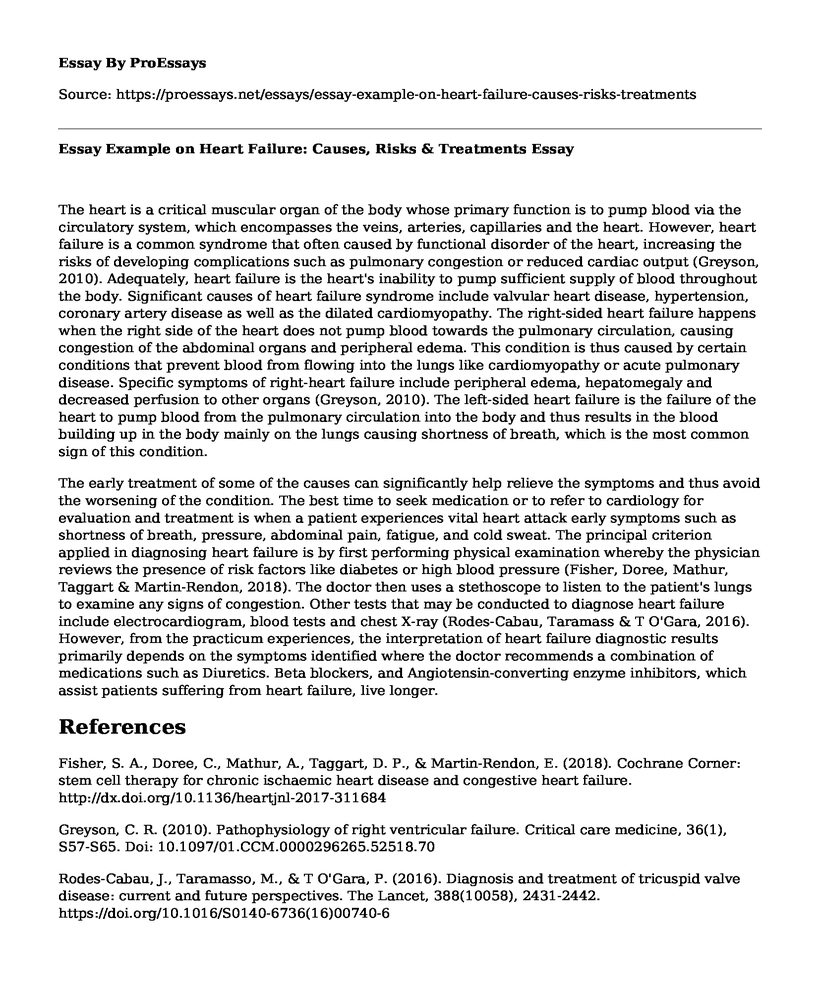The heart is a critical muscular organ of the body whose primary function is to pump blood via the circulatory system, which encompasses the veins, arteries, capillaries and the heart. However, heart failure is a common syndrome that often caused by functional disorder of the heart, increasing the risks of developing complications such as pulmonary congestion or reduced cardiac output (Greyson, 2010). Adequately, heart failure is the heart's inability to pump sufficient supply of blood throughout the body. Significant causes of heart failure syndrome include valvular heart disease, hypertension, coronary artery disease as well as the dilated cardiomyopathy. The right-sided heart failure happens when the right side of the heart does not pump blood towards the pulmonary circulation, causing congestion of the abdominal organs and peripheral edema. This condition is thus caused by certain conditions that prevent blood from flowing into the lungs like cardiomyopathy or acute pulmonary disease. Specific symptoms of right-heart failure include peripheral edema, hepatomegaly and decreased perfusion to other organs (Greyson, 2010). The left-sided heart failure is the failure of the heart to pump blood from the pulmonary circulation into the body and thus results in the blood building up in the body mainly on the lungs causing shortness of breath, which is the most common sign of this condition.
The early treatment of some of the causes can significantly help relieve the symptoms and thus avoid the worsening of the condition. The best time to seek medication or to refer to cardiology for evaluation and treatment is when a patient experiences vital heart attack early symptoms such as shortness of breath, pressure, abdominal pain, fatigue, and cold sweat. The principal criterion applied in diagnosing heart failure is by first performing physical examination whereby the physician reviews the presence of risk factors like diabetes or high blood pressure (Fisher, Doree, Mathur, Taggart & Martin-Rendon, 2018). The doctor then uses a stethoscope to listen to the patient's lungs to examine any signs of congestion. Other tests that may be conducted to diagnose heart failure include electrocardiogram, blood tests and chest X-ray (Rodes-Cabau, Taramass & T O'Gara, 2016). However, from the practicum experiences, the interpretation of heart failure diagnostic results primarily depends on the symptoms identified where the doctor recommends a combination of medications such as Diuretics. Beta blockers, and Angiotensin-converting enzyme inhibitors, which assist patients suffering from heart failure, live longer.
References
Fisher, S. A., Doree, C., Mathur, A., Taggart, D. P., & Martin-Rendon, E. (2018). Cochrane Corner: stem cell therapy for chronic ischaemic heart disease and congestive heart failure. http://dx.doi.org/10.1136/heartjnl-2017-311684
Greyson, C. R. (2010). Pathophysiology of right ventricular failure. Critical care medicine, 36(1), S57-S65. Doi: 10.1097/01.CCM.0000296265.52518.70
Rodes-Cabau, J., Taramasso, M., & T O'Gara, P. (2016). Diagnosis and treatment of tricuspid valve disease: current and future perspectives. The Lancet, 388(10058), 2431-2442. https://doi.org/10.1016/S0140-6736(16)00740-6
Cite this page
Essay Example on Heart Failure: Causes, Risks & Treatments. (2023, Jan 16). Retrieved from https://proessays.net/essays/essay-example-on-heart-failure-causes-risks-treatments
If you are the original author of this essay and no longer wish to have it published on the ProEssays website, please click below to request its removal:
- The Theory of Bureaucratic Caring for Nursing Practice
- Child Crisis Arizona: Speech
- My Developmental and Health History Paper Example
- Essay Example on Netherlands: Standard of Living, Literacy & Healthcare
- SARS: Acute Respiratory Illness With Fatal Outcomes - Research Paper
- Free Essay Sample on CBT vs Existential-Humanistic Therapy: A Comparison
- My Personal Nursing Philosophy - Free Essay Example







